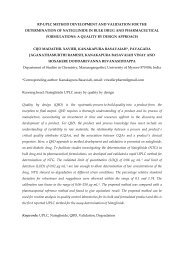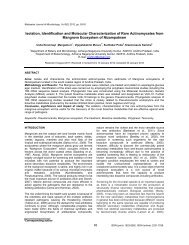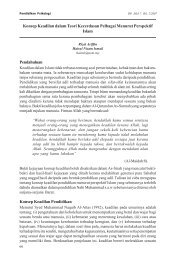"Acceptability" in the Translation into Malay of Rihlat Ibn ... - USM
"Acceptability" in the Translation into Malay of Rihlat Ibn ... - USM
"Acceptability" in the Translation into Malay of Rihlat Ibn ... - USM
You also want an ePaper? Increase the reach of your titles
YUMPU automatically turns print PDFs into web optimized ePapers that Google loves.
6 Idris Mansor<br />
1. Product-oriented translation studies.<br />
2. Function-oriented translation studies.<br />
3. Process-oriented translation studies.<br />
In A Rationale for Descriptive <strong>Translation</strong>, Toury (1985, 16) suggests that DTS<br />
is <strong>the</strong> best means that can be used by translation researchers to test, refute,<br />
modify and amend <strong>the</strong> underly<strong>in</strong>g <strong>the</strong>ory on <strong>the</strong> basis <strong>of</strong> which <strong>the</strong> translation<br />
work is be<strong>in</strong>g carried out. This is because DTS <strong>of</strong>fers replicability, <strong>the</strong> overall<br />
goal <strong>of</strong> mak<strong>in</strong>g generalisations and identify<strong>in</strong>g norms and laws.<br />
With regard to DTS, Toury (1995, 36–39) proposes a three-phase methodology<br />
for systematic descriptive studies:<br />
1. Consider <strong>the</strong> text with<strong>in</strong> <strong>the</strong> system <strong>of</strong> <strong>the</strong> target culture, <strong>in</strong> order<br />
to look at its significance or acceptability.<br />
2. Make a comparison between <strong>the</strong> ST and <strong>the</strong> TT by mapp<strong>in</strong>g <strong>the</strong><br />
TT onto <strong>the</strong> ST, so that <strong>the</strong> relationships between "coupled pairs"<br />
<strong>of</strong> <strong>the</strong> ST and TT segments can be exam<strong>in</strong>ed.<br />
3. Formulate generalisations and make conclusions for <strong>the</strong> future<br />
translation process.<br />
In addition to this three-phase methodology, Toury (1995, 39) proposes an<br />
important additional step, which is <strong>the</strong> possibility <strong>of</strong> repeat<strong>in</strong>g <strong>the</strong> process for<br />
o<strong>the</strong>r pairs <strong>of</strong> similar texts <strong>in</strong> order "to widen <strong>the</strong> corpus and to build up a<br />
descriptive pr<strong>of</strong>ile <strong>of</strong> translations accord<strong>in</strong>g to genre, period, author, etc"<br />
(Munday 2008, 111). From this framework <strong>the</strong> norms <strong>of</strong> translation can be<br />
identified and, consequently, laws <strong>of</strong> translation will be uncovered.<br />
A modified version <strong>of</strong> V<strong>in</strong>ay and Darbelnet's translation procedures<br />
V<strong>in</strong>ay and Darbelnet (1958/1995) identified two ma<strong>in</strong> strategies <strong>in</strong> translation:<br />
direct and oblique translation. Direct translation consists <strong>of</strong> three procedures:<br />
borrow<strong>in</strong>g, calque and literal translation, while oblique translation consists <strong>of</strong><br />
four procedures: transposition, modulation, equivalence and adaptation. In<br />
addition to <strong>the</strong> seven pr<strong>in</strong>cipal procedures, <strong>the</strong>re are o<strong>the</strong>r common procedures<br />
which are particularly relevant to <strong>the</strong> analysis <strong>of</strong> data <strong>in</strong> this present study;<br />
explicitation, deletion and generalisation.<br />
i. Borrow<strong>in</strong>g<br />
Borrow<strong>in</strong>g refers to <strong>the</strong> process <strong>of</strong> transferr<strong>in</strong>g SL words <strong>in</strong>to <strong>the</strong><br />
TL (V<strong>in</strong>ay and Darbelnet 1958/1995, 31). They (pp. 31–32)<br />
justify <strong>the</strong> need for borrow<strong>in</strong>g <strong>in</strong> translation by referr<strong>in</strong>g to




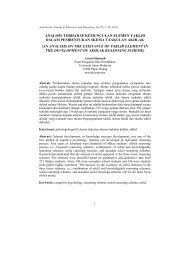
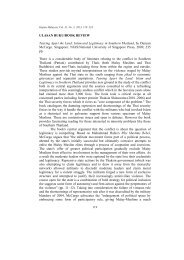

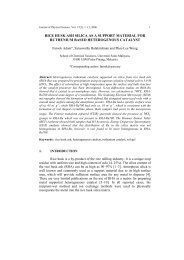

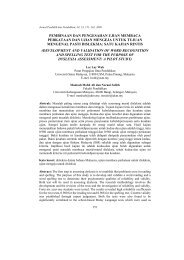
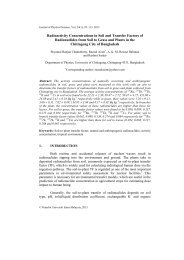
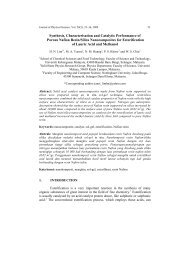

![KTT 111 – Inorganic Chemistry I [Kimia Takorganik I] - USM](https://img.yumpu.com/12405642/1/184x260/ktt-111-inorganic-chemistry-i-kimia-takorganik-i-usm.jpg?quality=85)
